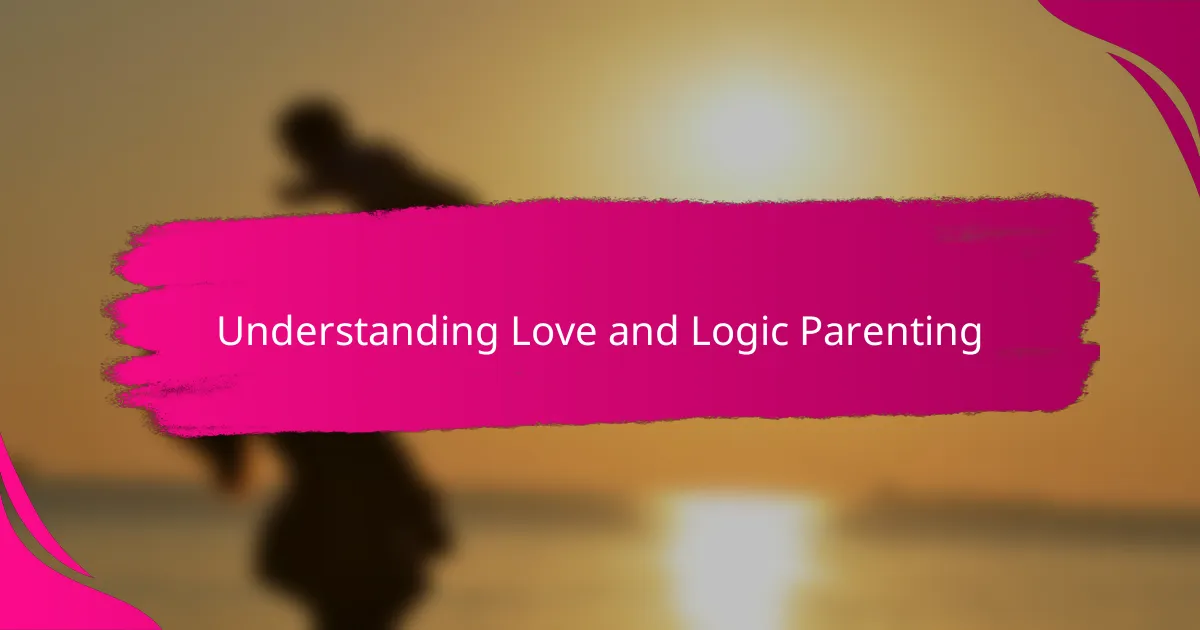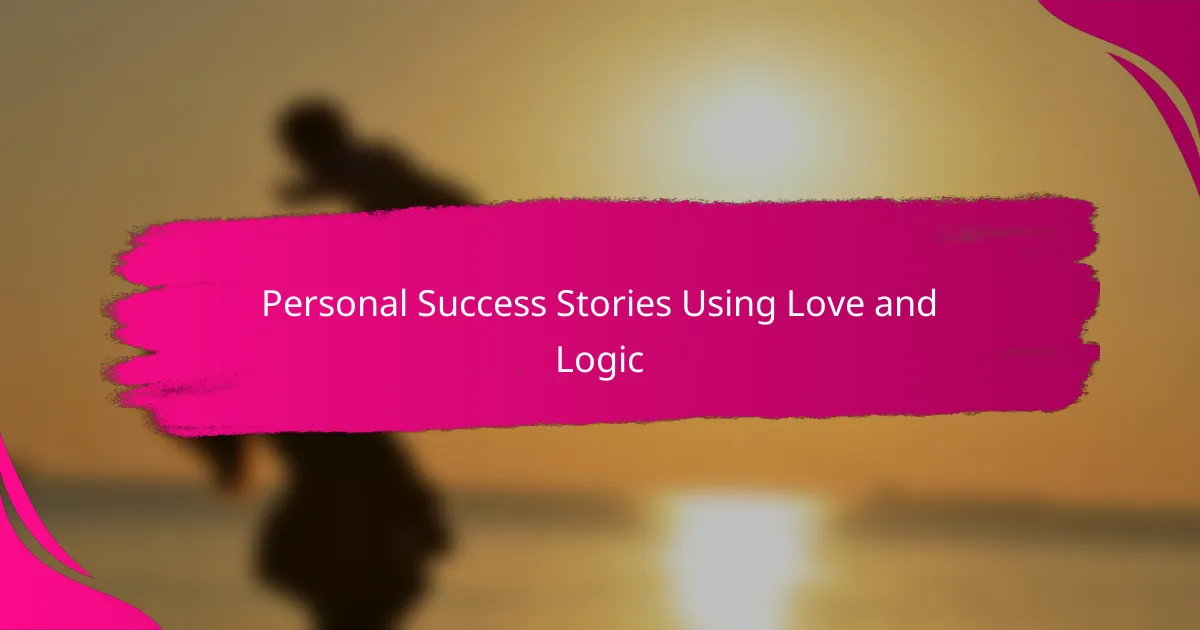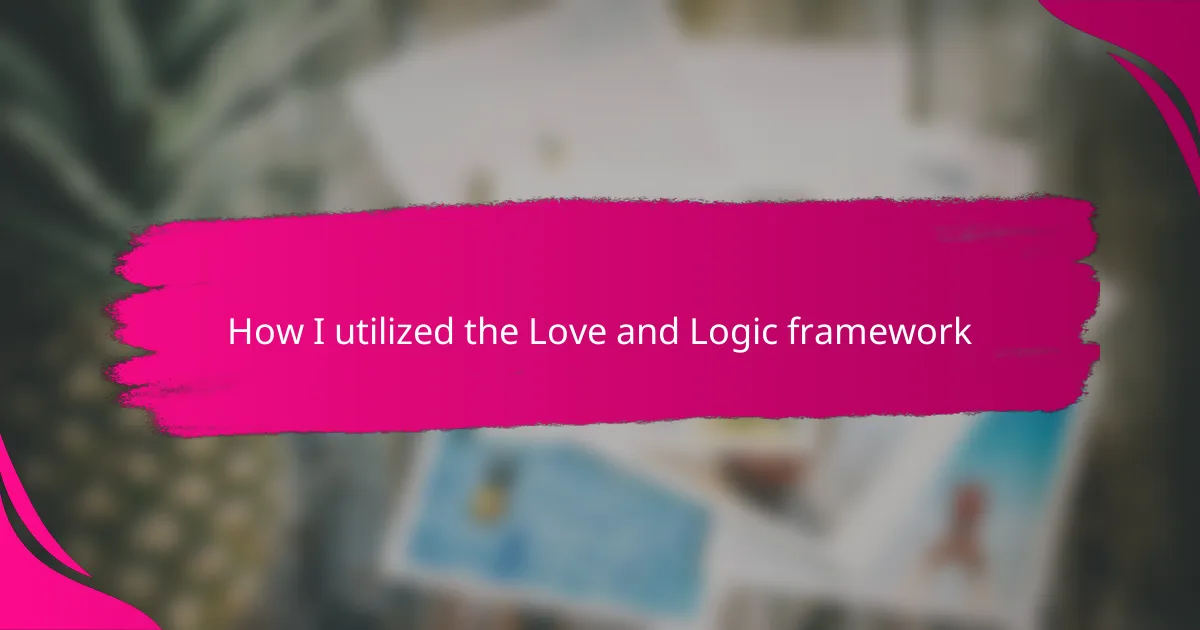Key takeaways
- Love and Logic parenting encourages children to learn from natural consequences while being supported by empathy and guidance.
- Key principles include offering choices within limits, staying calm during challenges, and allowing children to face the outcomes of their decisions.
- This approach fosters respect and cooperation, reduces parental stress, and helps children develop into confident problem-solvers.
- Consistent implementation transforms everyday moments into teaching opportunities, nurturing trust and emotional growth in both parents and children.

Understanding Love and Logic Parenting
Love and Logic parenting, in my experience, feels like a breath of fresh air amidst the chaos of daily discipline challenges. It’s built on the simple yet powerful idea that children learn best when they experience natural consequences wrapped in love and guidance. Have you ever noticed how much more your child listens when they know you’re not just laying down rules but genuinely caring about their learning?
What struck me most about Love and Logic is its focus on empathy and respect, rather than control. Instead of reacting with frustration when my kids misbehave, I learned to stay calm and let them face the outcomes of their choices. This shift didn’t just change their behavior; it transformed our relationship and my own approach to parenting.
I often wonder, why do we so often rush to fix things for our children instead of letting them solve problems on their own? Love and Logic encourages parents to hold their children accountable in a nurturing way, which I’ve found fosters both responsibility and independence. It’s a subtle but profound difference that made me rethink what it truly means to guide my kids.

Core Principles of Love and Logic
At the heart of Love and Logic are a few core principles that turned my approach around. One that really hit home was the idea of offering choices within limits—letting my children feel empowered while still keeping boundaries clear. It’s amazing how much more cooperative kids can be when they’re part of the decision-making process, don’t you think?
Another principle that reshaped my mindset is the importance of staying calm—no matter how challenging the moment gets. I used to react quickly with frustration, but Love and Logic taught me that calmness models the kind of behavior I want from my kids. It’s not always easy, but the peace it brings to our interactions is worth every effort.
Perhaps the most surprising lesson was embracing natural consequences instead of jumping in to rescue or punish. Watching my children experience the results of their choices, even when it meant a little setback, showed me how resilient and responsible they could be. Have you noticed how powerful those moments become when children learn from their own experiences rather than just being told what to do?

Benefits of Using Love and Logic
One of the biggest benefits I’ve experienced with Love and Logic is how it naturally builds respect between me and my kids. When I offer choices and hold them accountable with empathy, it feels like we’re working together instead of me just enforcing rules. Have you ever seen how much more they respond when they sense you truly respect their feelings and decisions?
I also noticed a powerful shift in my own stress levels. Staying calm—even when they test boundaries—created a calmer home environment for all of us. It’s amazing how my patience, modeled in tough moments, taught my children to regulate their emotions too. That kind of emotional balance feels like a win for the whole family.
Perhaps the most rewarding part has been watching my children grow into confident problem-solvers. Instead of rushing in to fix everything, I’ve seen them take pride in handling consequences and making better choices next time. Doesn’t it feel incredible when you witness that spark of independence light up in your child? That, to me, is the heart of Love and Logic’s true benefit.

Implementing Love and Logic Daily
Using Love and Logic daily meant turning everyday moments into teaching opportunities, which wasn’t always easy at first. I remember one morning when my son refused to get dressed on time—I resisted the urge to nag and instead calmly offered him a choice between two outfits, which surprisingly led to less resistance and a smoother start to the day. Have you noticed how simple choices can really shift the power dynamic with your kids?
Consistency became my secret weapon; by sticking to Love and Logic principles each day, I saw how predictable and fair boundaries helped my children feel safer and more understood. Of course, some days were tougher than others—times when patience ran thin and my calm was tested—but I found that even then, taking a deep breath before responding made all the difference. Isn’t it interesting how our own mindset can either escalate or defuse challenging moments?
I also realized that daily implementation didn’t mean perfection but presence. Being there to listen, acknowledging feelings without immediately jumping in to fix things, created a space where my kids felt heard and empowered. Over time, those small moments added up, nurturing trust and responsibility in ways I hadn’t anticipated. Have you tried simply sitting back and letting your children work through their choices? It’s remarkable what they can teach us about patience and growth.

Overcoming Challenges with Love and Logic
Challenges didn’t disappear overnight when I started using Love and Logic, but I found myself facing them differently. Instead of reacting with frustration, I learned to step back and let natural consequences do their work, which, though uncomfortable at first, created more meaningful lessons for my kids. Have you ever noticed how much more kids seem to learn when they experience the outcome of their choices firsthand?
There were moments when staying calm felt almost impossible—like during bedtime battles or when homework was repeatedly ignored. Yet, the more I practiced patience and offered choices rather than ultimatums, the more those tough moments softened. I realized that modeling calm helped my children regulate their emotions too, making our home feel less like a battlefield and more like a team effort.
Sometimes, the biggest challenge was resisting the urge to “fix” everything immediately. It’s tempting to jump in and solve problems for our kids, but I discovered that by stepping back and allowing them to navigate setbacks, I was helping build their confidence and problem-solving skills. Isn’t it rewarding to see your child take responsibility and grow stronger through challenges you once thought had to be controlled?

Personal Success Stories Using Love and Logic
One story that sticks with me is when my daughter forgot her homework at home. Instead of rushing to fix it, I calmly let her face the natural consequence at school. At first, it was tough to hold back the urge to rescue her, but seeing her take responsibility and figure out how to manage the situation honestly made me proud beyond words. Have you noticed how these moments can really build character in our kids?
Another success came during a sibling disagreement where patience was running thin. Instead of stepping in as the referee, I offered both kids choices about how to resolve the conflict. Watching them negotiate and come to an agreement on their own was so rewarding—it reminded me that sometimes stepping back lets them shine. Isn’t it amazing how empowering it is when children feel trusted to handle their own problems?
I also recall times when I struggled to stay calm amid the chaos, yet sticking to Love and Logic’s principles paid off. For example, during a particularly rough afternoon meltdown, maintaining my calm helped my son calm down faster and regain control himself. Moments like these taught me that my own emotional steadying can be the greatest gift I give my children. Have you found that your calm can be contagious in challenging times?
